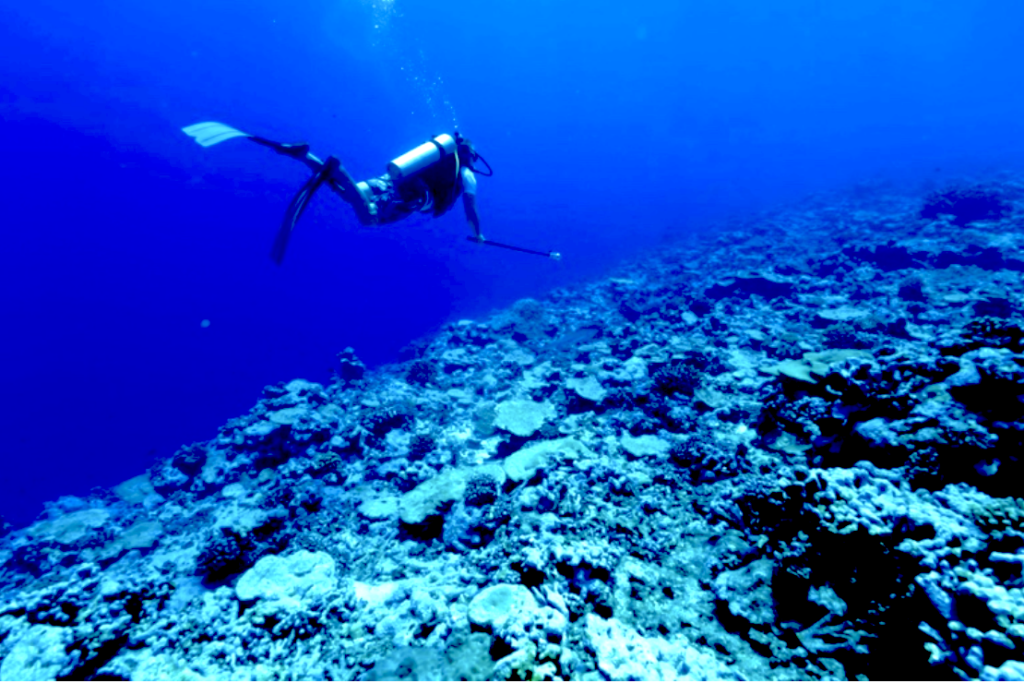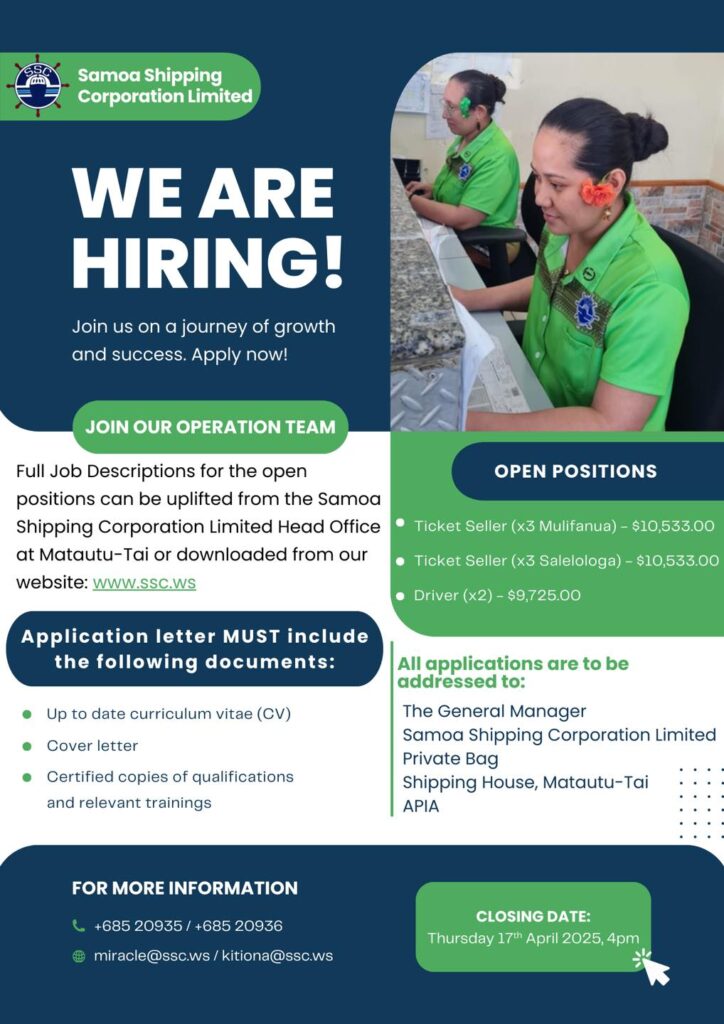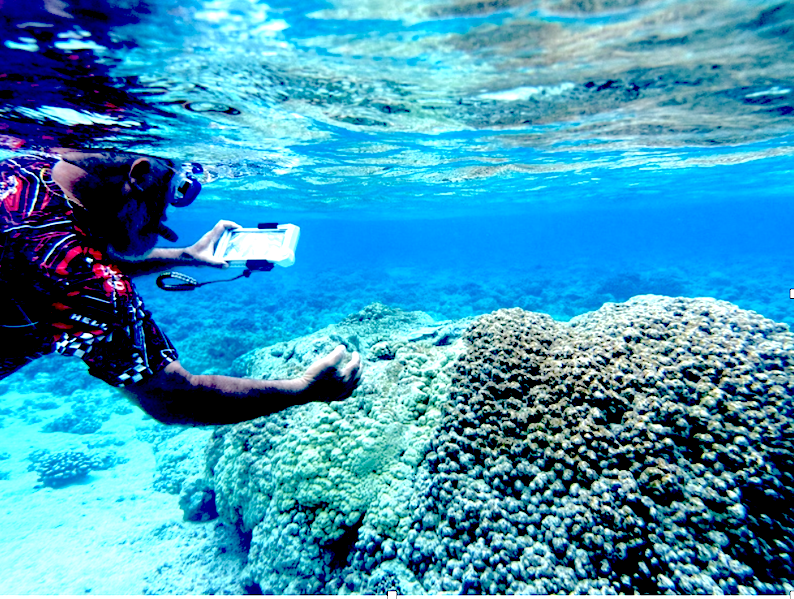Expedition reveals signs of coral reef recovery and thriving seabird populations in Tokelau—local leaders welcome findings and look ahead to new environmental education tools for schools

van Dijken using 360 camera to survey reef in 8k resolution. Photo ‘New Zealand Geographic’.
Coral reef recovery following past bleaching events are among the encouraging results emerging from a recent study expedition of the Tokelau Island ecosystem.

Thriving bird population and the absence of invasive myna birds is another bright finding revealed by the study.
All the three Tokelau Atolls came under a week of intensive scientific assessment to document encouraging signs of ecosystem recovery and establishing new pathways for community-led environmental monitoring.
The expedition team, led by Conservation International started work in late March from the 27th in Atafu, continued through Nukunonu to Fakaofo, and culminated with final consultations with the Fakaofo Taupulega.
Conservation International worked together with the New Zealand Geographic, the Samoa Conservation Society, and the Tokelau Government’s Economic Department of Natural Resources and Environment (EDNRE).
There was critical support from the New Zealand Ministry of Foreign Affairs and Trade (MFAT) and Blackmores Foundation in what represents the most thorough environmental survey of Tokelau’s ecosystems in nearly two decades.

Coral harvesting for on-growing planting. Photo ‘‘New Zealand Geographic’.
The Taupulega (Council of Elders) of each atoll expressed keen anticipation for the team’s return in the coming months with the final expedition report and the Tokelau Environmental Education Resource Kit for Primary Schools—tools that will further empower local communities and future generations in environmental stewardship.

Leausalilo Leilani Duffy of Conservation International Samoa led community consultations across all three atolls, engaging with men’s groups (Aumaga/Taulele’a), women’s groups (Fatupaepae), and youth representatives. “The message from every community was clear—they want to remain and build in Tokelau and are committed to environmental stewardship that combines their traditional practices with more modern scientific approaches” Duffy explained. “There’s strong enthusiasm for adapting the Guardians environmental education program we’ve co-developed in Samoa to the Tokelauan context, particularly its integration of cultural elements with canoe-making and traditional songs with environmental education.”
Along with the Taupulega,, the women’s groups across all atolls expressed particular concern about waste management, coral bleaching impacts on important resources like giant clams, and the need to transfer traditional practices to younger generations while incorporating updated scientific approaches.

Reef photogrammetry in action, using a iPhone in special case with specific app, documenting reef health and creating a 3D model from all the images that will be collected. Photo ‘New Zealand Geographic’
“These are reefs in recovery,” reported Conservation International Aotearoa’s Leausalilo Schannel van Dijken. “Despite evidence of a significant bleaching event in recent years, we’re seeing promising signs of regeneration. This recovery has been possible because of healthy fish populations across all trophic levels, including the presence of apex predators like sharks at each site. The traditional leadership of the Taupulega has clearly played a crucial role in maintaining reef health by effectively managing access to ocean-side fishing grounds.”
The multi-disciplinary team conducted surveys across all three atolls—Atafu, Nukononu, and Fakaofo—documenting marine biodiversity, lagoon health, invasive species presence, and bird populations while simultaneously training local community members in cutting-edge monitoring techniques.

“What makes this expedition groundbreaking is how we’re integrating traditional approaches with cutting-edge technologies like 360 cameras, VR and photogrammetry” added van Dijken. “By training local community members in scientific techniques, we’re building a network of citizen scientists who can continue monitoring these reefs after we leave. This blend of innovation and traditional stewardship creates a powerful model for sustainable marine conservation.”
Marine assessments revealed that each point around each atoll were Key Biodiversity Areas, due to the consistent presence of sharks, bumphead parrot fish, and coral cods, along with healthy stocks of the Endangered humphead wrasse and turtles.
Lagoon surveys identified that there was less than 50% live coral cover, predominantly Porites – a stone coral species – with evidence of recovering from a bleaching event. Encouragingly there was little algae due to abundant herbivorous fish keeping reefs clean for new coral recruitment. A finding confirmed with offshore reefs.

Fatupaepae Fakaofo Consultation, Photo ‘CONSERVATION INTERNATIONAL’
The team also documented varying giant clam populations across the atolls, with a ten-year export ban instituted in 2015 showing positive impacts for local consumption sustainability.
Meanwhile, surveys on land revealed significant conservation successes, with reduced populations of invasive yellow crazy ants compared to 2012 assessments, and some surveyed islets now entirely free of both rats and invasive ants. The surveys also found increased bird populations, including noddies, sooty terns, frigates, and red-footed boobies, which play vital roles in nutrient cycling on these naturally nutrient-poor atolls.
A key component of the expedition involved training local people in reef photogrammetry techniques for ongoing monitoring. “It’s really cool,” remarked Olisha (Olly) Tuisano, a recent marine science graduate from the University of the South Pacific now residing in Fakaofo. The team trained 2-3 people on each atoll, including Ministry of Climate, Oceans and Resilience staff who have already established and are maintaining coral nurseries.
The expedition team also collected environmental DNA (eDNA) samples from each atoll’s lagoon and inter-island areas, which will be analyzed to provide a comprehensive baseline of marine biodiversity.
Throughout the mission, New Zealand Geographic documented Tokelau’s environment and community life in immersive 360-degree virtual reality, creating resources that will allow schools and overseas Tokelauans to experience their environment virtually.